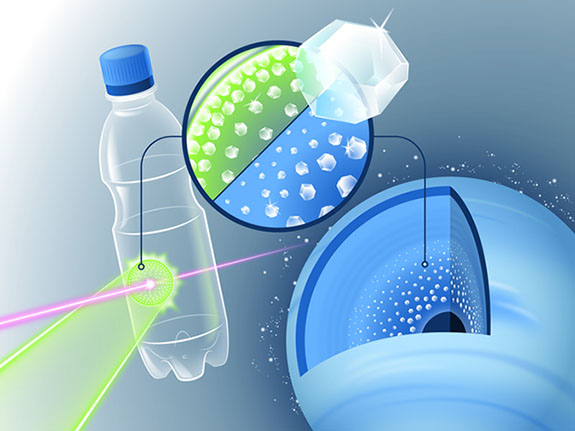September 8th, 2022
In the spirit of the ancient alchemists who spent countless hours attempting to transmute cheap metals into gold, scientists from Germany’s HZDR research lab recently turned ordinary plastic into diamonds. For real.

In the experiment, researchers blasted a thin sheet of plastic — the kind used to make plastic bottles — with powerful lasers, briefly heating the material to 6,000 degrees Celsius. The extreme heat, pressure and resulting shock wave compressed the plastic into tiny "nanodiamonds."
For a brief moment in the lab, scientists simulated the conditions in the interior of icy giant planets, such as Neptune and Uranus, where temperatures reach several thousand degrees Celsius and the pressure is millions of times greater than in the Earth’s atmosphere.
Ice giants not only contain carbon and hydrogen but also vast amounts of oxygen. When searching for suitable film material, the researchers hit on an everyday substance: PET, the resin out of which ordinary plastic bottles are made.
“The effect of the oxygen was to accelerate the splitting of the carbon and hydrogen and thus encourage the formation of nanodiamonds,” said Dominik Kraus, an author of the study, which was published in the journal Science Advances. “It meant the carbon atoms could combine more easily and form diamonds.”
The results of the experiment support the assumption that it literally rains diamonds inside the ice giants. The researchers noted that the findings are probably not just relevant to Uranus and Neptune, but to innumerable other planets in our galaxy, as well. While such ice giants used to be thought of as rarities, it now seems clear that they are probably the most common form of planet outside the solar system, they wrote.
The laser experiment also points to new methods for creating tiny diamonds to be used for industrial abrasives and polishing agents, quantum sensors and other applications.
“So far, diamonds of this kind have mainly been produced by detonating explosives,” Kraus explained. “With the help of laser flashes, they could be manufactured much more cleanly in the future.”
The team conducted its experiments at SLAC National Accelerator Laboratory in California, the location of the Linac Coherent Light Source (LCLS), a powerful, accelerator-based X-ray laser.
Credit: Image courtesy of HZDR / Blaurock.

In the experiment, researchers blasted a thin sheet of plastic — the kind used to make plastic bottles — with powerful lasers, briefly heating the material to 6,000 degrees Celsius. The extreme heat, pressure and resulting shock wave compressed the plastic into tiny "nanodiamonds."
For a brief moment in the lab, scientists simulated the conditions in the interior of icy giant planets, such as Neptune and Uranus, where temperatures reach several thousand degrees Celsius and the pressure is millions of times greater than in the Earth’s atmosphere.
Ice giants not only contain carbon and hydrogen but also vast amounts of oxygen. When searching for suitable film material, the researchers hit on an everyday substance: PET, the resin out of which ordinary plastic bottles are made.
“The effect of the oxygen was to accelerate the splitting of the carbon and hydrogen and thus encourage the formation of nanodiamonds,” said Dominik Kraus, an author of the study, which was published in the journal Science Advances. “It meant the carbon atoms could combine more easily and form diamonds.”
The results of the experiment support the assumption that it literally rains diamonds inside the ice giants. The researchers noted that the findings are probably not just relevant to Uranus and Neptune, but to innumerable other planets in our galaxy, as well. While such ice giants used to be thought of as rarities, it now seems clear that they are probably the most common form of planet outside the solar system, they wrote.
The laser experiment also points to new methods for creating tiny diamonds to be used for industrial abrasives and polishing agents, quantum sensors and other applications.
“So far, diamonds of this kind have mainly been produced by detonating explosives,” Kraus explained. “With the help of laser flashes, they could be manufactured much more cleanly in the future.”
The team conducted its experiments at SLAC National Accelerator Laboratory in California, the location of the Linac Coherent Light Source (LCLS), a powerful, accelerator-based X-ray laser.
Credit: Image courtesy of HZDR / Blaurock.


